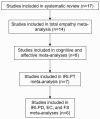Cognitive and Affective Empathy in Eating Disorders: A Systematic Review and Meta-Analysis
- PMID: 30886590
- PMCID: PMC6410675
- DOI: 10.3389/fpsyt.2019.00102
Cognitive and Affective Empathy in Eating Disorders: A Systematic Review and Meta-Analysis
Abstract
Background: Recent models of eating disorders (EDs) have proposed social and emotional difficulties as key factors in the development and maintenance of the illness. While a number of studies have demonstrated difficulties in theory of mind and emotion recognition, little is known about empathic abilities in those with EDs. Further, few studies have examined the cognitive-affective empathy profile in EDs. The aim of this systematic review and meta-analysis was to provide a synthesis of empathy studies in EDs, and examine whether those with EDs differ from healthy controls (HC) on self-reported total, cognitive, and affective empathy. Methods: Electronic databases were systematically searched for studies using self-report measures of empathy in ED populations. In total, 17 studies were identified, 14 of which could be included in the total empathy meta-analysis. Eight of the 14 studies were included in the cognitive and affective empathy meta-analyses. Results: Meta-analyses showed that while total empathy and affective empathy scores did not differ between those with anorexia nervosa (AN) and HC, those with AN had significantly lower cognitive empathy scores compared to HCs (small effect size). Meta-analyses of Interpersonal Reactivity Index sub-scores revealed that AN had significantly lower Fantasy scores than HC (small effect size), indicating that those with AN have more difficulty in identifying themselves with fictional characters. Only 3 studies examined empathy in those with bulimia nervosa (BN) or binge eating disorder (BED). Conclusions: The lowered cognitive empathy and intact affective empathy profile found in AN is similar to that found in other psychiatric and neurodevelopmental conditions, such as autism spectrum disorder (ASD). These findings add to the literature characterizing the socio-emotional phenotype in EDs. Future research should examine the influence of comorbid psychopathology on empathy in EDs.
Keywords: anorexia nervosa; autism; eating disorders; empathy; insight; self-report.
Figures








Similar articles
-
Autism spectrum disorder traits are associated with empathic abilities in adults with anorexia nervosa.J Affect Disord. 2020 Apr 1;266:273-281. doi: 10.1016/j.jad.2020.01.169. Epub 2020 Jan 29. J Affect Disord. 2020. PMID: 32056888
-
Associations between bone mineral density, body composition and amenorrhoea in females with eating disorders: a systematic review and meta-analysis.J Eat Disord. 2022 Nov 18;10(1):173. doi: 10.1186/s40337-022-00694-8. J Eat Disord. 2022. PMID: 36401318 Free PMC article. Review.
-
Empathy, mentalizing, and cognitive functioning in anorexia nervosa and bulimia nervosa.Soc Neurosci. 2020 Aug;15(4):477-488. doi: 10.1080/17470919.2020.1760131. Epub 2020 May 13. Soc Neurosci. 2020. PMID: 32321371
-
An updated transdiagnostic review of social cognition and eating disorder psychopathology.J Psychiatr Res. 2021 Nov;143:602-627. doi: 10.1016/j.jpsychires.2020.11.019. Epub 2020 Nov 9. J Psychiatr Res. 2021. PMID: 33190838 Review.
-
Outcomes in people with eating disorders: a transdiagnostic and disorder-specific systematic review, meta-analysis and multivariable meta-regression analysis.World Psychiatry. 2024 Feb;23(1):124-138. doi: 10.1002/wps.21182. World Psychiatry. 2024. PMID: 38214616 Free PMC article.
Cited by
-
The "Measure of Empathy in Early Childhood": Psychometric Properties and Associations with Externalizing Problems and Callous Unemotional Traits.Child Psychiatry Hum Dev. 2024 Jan 23. doi: 10.1007/s10578-024-01673-7. Online ahead of print. Child Psychiatry Hum Dev. 2024. PMID: 38261151
-
Altered social cognition in a community sample of women with disordered eating behaviours: a multi-method approach.Sci Rep. 2021 Jul 19;11(1):14683. doi: 10.1038/s41598-021-94117-4. Sci Rep. 2021. PMID: 34282195 Free PMC article.
-
The Dark and Light Sides of Empathy: The Clinical Relevance of the Assessment of Cognitive and Affective Empathy Across Negative and Positive Emotions.Eur J Investig Health Psychol Educ. 2025 Mar 18;15(3):38. doi: 10.3390/ejihpe15030038. Eur J Investig Health Psychol Educ. 2025. PMID: 40136776 Free PMC article.
-
Impairments in personality functioning in adolescents with anorexia nervosa.Eur Eat Disord Rev. 2025 Mar;33(2):360-373. doi: 10.1002/erv.3146. Epub 2024 Oct 28. Eur Eat Disord Rev. 2025. PMID: 39468697 Free PMC article.
-
Difficulties in Emotion Regulation, Alexithymia, and Social Phobia Are Associated With Disordered Eating in Male and Female Undergraduate Athletes.Front Psychol. 2020 Jul 22;11:1646. doi: 10.3389/fpsyg.2020.01646. eCollection 2020. Front Psychol. 2020. PMID: 32774318 Free PMC article.
References
Publication types
Grants and funding
LinkOut - more resources
Full Text Sources

